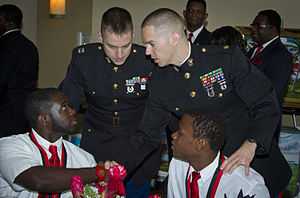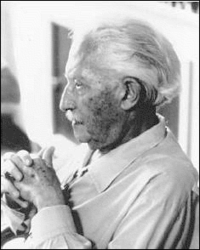Motivation and emotion/Book/2014/Role models and motivation
< Motivation and emotion < Book < 2014The motivational influence of role models on adolescents
|
|
Who Are Role Models?
%2C_helps_a_child_read_a_book_at_Holomua_Elementary_School_in_Ewa_Beach%2C_Hawaii.jpg)
Different role models inspire and motivate youth in various ways, through behaviours, the way they present themselves to admirable career paths. Role models are people who are influential, they have the capability to motivate youth to create a goal and to achieve a vision. Often youth motivation is instigated through role models’ life experiences of achievements and setbacks that they have overcome (MacCallum & Beltman, 2002). Role models tend to impose a particular message to a specific targeted demographic which has relevance and importance to them. These messages aim to guide adolescents to be determined and persevere through challenging obstacles. Researchers have established that adolescents are significantly more motivated to achieve or accomplish a skill or behaviour when they have a role model as guidance or inspiration. Role models can be referred to as anyone who has the ability to motivate one to behave or think in ways (sport stars, celebrities, leaders, family and friends, teachers and even strangers you encounter) (Abbasi, 2009).  MacCallum & Beltman (2002) and Brustad & Partridge (2002) have conducted studies on youth that established that qualities such as passion and ability to listen, possessing a clear set of values, commitment to community, selflessness/fearlessness and confidence of others’ ability to overcome obstacles are major influential traits that roles models exhibit. MentorA mentor is a type of role model who is relationship-orientated and is driven in providing self-development through consistent motivation and guidance (Harris & Sass, 2011). Researchers have recognised that mentors tend to be more motivational and inspirational to youth as their focus goes beyond achieving goals and development of skills, such as, self-respect, self-esteem and self-efficacy. With the guidance of effective mentors, they have been proven to assist and encourage adolescents to believe that they have the ability to transition to become successful young adults (Abbasi, 2009; MacCallum & Beltman, 2002). CoachResearch has recognised coaching as a short-term role model (Duerden & Witt, 2010). Duerden & Witt (2010) had stated that youth utilises coaches as role models to develop current skills or acquire new skills, however, once adolescents have successfully mastered particular qualities, the coach is no longer necessary. |
Role Models Influence on Adolescents
Adolescents in particular are more likely to emulate role models, especially public figures, however their behaviours may not always be positive or constructive to the development of youth. Many examples have been drawn out through the media with celebrities displaying disrespectful behaviour and undesirable traits (Deurden & Witt, 2010; Wells & Lekies, 2006). Celebrities are often reported through media for delinquent and violent behaviours, self-harm including the glamorisation of eating disorders and substance and alcohol abuse, this has the potential for a detrimental effect on adolescents who aspire and use them as a role model (Wells & Lekies, 2009; Brook, Adams, Balka & Johnson, 2002). Researchers have outlined that adolescents can have more than one role model and other positive role models are required in adolescents’ lives are greatly needed to guide and motivate youth into the right direction through inspiration and consistent support. It has been established that positive role models have led to better academic performance, higher self-esteem and are more equipped in confronting stressful problems and obstacles (Abbasi, 2009; Larson, Hansen & Moneta, 2004). Furthermore, decreasing the chances of eating disorders, depression, anxiety and mood disorders (Larson, Hansen & Moneta, 2004).
Shields, Bredeier, LaVoi & Power (2005) and Miller, Roberts & Ommundsen (2004,2005) outlined that positive and constructive traits such as perseverance, good sportsmanship and positive moral principles are traits role models can exhibit to influence to assist development of youth into responsible and respectable young adults. In the aim to promote good behaviour, role models are increasingly endorsing binge drinking and substance use prevention campaigns, through advocating the significance of a healthy lifestyle and emphasising the consequences of delinquent behaviour and drug and alcohol abuse (Lin, 2013).
|
Real Life Role Model for Adolescents  [[w:Emma Watson|Emma Watson], is a good example of an effective and positive role model within society. Adolescents recognised her as playing one of the lead roles in Harry Potter franchise (Hermione Granger). Unlike other celebrities who are entirely focused on fame and fortune, Watson stalled her acting career and used her wealth to support her education, she attended Brown University and attained a degree in English literature. Her positive traits and attitude towards study and academia inspires youth to also focus on education. Positive role models like Ms Watson, guide and support youth to into the right direction (Pickering, 2014). |
Theoretical ApproachesErikson's Psychosocial Development Stages: Identity vs ConfusionErik Erikson (1963; 1968) has focused studies on Psychosocial developmental stages of adolescents and the factors that influence the formation of identity. Achieving a sense of identity vs role confusion is the fifth stage of Erikson’s psychosocial development. This stage occurs between the ages of 12 to 18 years (Erikson, 1963). Throughout this stage, adolescents are vulnerable to bad influences and negative traits of their role models, they may also find it difficult to cope with moral issues and social interactions. As a result, adolescents may experiment with different roles, activities and behaviours (MacCallum & Beltman, 2002). Abbasi (2009) suggests that adolescents greatly rely on role models within this stage to motivate them and guide them to develop a sense of self and personal identity.  Identity vs Confusion in Aspect to Role ModellingErikson (1968) has outlined that this stage is an imperative stage in creating social relationships and interests, modelling identity, and sense of direction. In regards to identity formation, Erikson (1968) elaborates that identity is consistently changing with our external environment, it is standard for our identities to form and reform throughout our lives. MacCallum & Beltman (2002) and Abbasi (2009) had stated that as personal interests in adolescents’ change, identity and roles are disposed to alter. Due to this role models are consistently changing to support adolescents’ new interests and experimental roles that they have taken upon. According to Erikson, adolescents who are provided support and reinforcement from their role models have greater independence, self-control and sense of self. In contrast, adolescents who have an absence or lack support and reinforcement from their role models are prone to insecurity, role confusion and will lack confidence of their beliefs and desires in the future (Erikson, 1968). Erikson (1968) stated that successful formation of a strong identity through a role models’ encouragement and reassurance lead to adolescents having a higher quality fidelity. Erikson outlined that a quality of fidelity is the outcome of successfully completing this stage of development. A vast range of researchers have described fidelity to be the capability to persevere through obstacles, accepting and understanding other’s points of views even where there may be ideological differences and to live by society’s social norms and expectations (Erikson, 1963, 1968). It is viewed as a disciplined devotion and regarded as a fundamental strength adolescents are required to attain before moving onto the next stage of Erikson’s Psychosocial theory. Erikson specified that fidelity is a valuable trait to acquire to become successful and determined adults (Abbasi, 2009). Bandura's Social Learning Theory Social learning theory or also known as observational learning or vicarious learning theory, can be regarded as a key component of our daily lives. It is the idea that people are capable of learning new information and behaviours by interactions with people. This can be done by merely observing and studying the behaviour of others and it results in the modification of their own cognitions and behaviour (Bandura, 1977a). However, Bandura (1977a) established that behaviour and cognitive modelling can also arise through the absence of reinforcement and punishment stimuli. Social learning theory can be divided into three continuous reciprocal interactions: cognitive, behavioural and environmental influences. Consequently, reciprocal determinism is the notion that cognitive experiences, environmental events and overt behaviour are all contributing factors that influence one another (Bandura, 1977a). The theory’s main contributions is that the teaching of the new behaviours from model to observer and can be intentional and unintentional influences (Birmingham & Calabrese, 2013). Observational LearningAlbert Bandura had analysed children’s behaviour after watching an adult act aggressively or calmly towards a Bobo doll. Bandura established that children who were exposed to a model who behaved aggressively, such as kicking, hitting and punching the Bobo doll were predisposed to behave more violently towards the doll. Whereas, children who were exposed to the calm model would behave alike. These children demonstrated more gentle and calm behaviour and showed little or no aggression or violence towards the Bobo doll (Bandura, 1977). Bandura (1977) stated that most human behaviour is learnt observationally through modelling: from observing others, one forms an idea of how new behaviours are performed and on later occasions this coded information serves as a guide for action.  Chimpansees Demonstration of Social Learning. One chimpanzee watches another use a straw to extract a substance from the window, after that chimpanzee walks away the chimpanzee that was observing learns the same behaviour Observational Learning in Aspect to Role ModellingAt a young age (2-6) children learn the idea of gender roles and stereotypes through many factors which, as a result, influences their attitude and behaviours concerning gender roles (Bandura, 1986; Fredricks & Eccles, 2004). The majority of these attitudes and behaviours are learned through their role models (parents, teachers, and carers), they are then generally reinforced through the child’s experience with friends, classmates or through media and advertising (Moran, 2014). Observational learning and role models are influencing environmental factors that shape what is feminine and masculine (Fink & Kensicki, 2002). For example, a 3 year old boy may enjoy playing with Barbie dolls and isn’t embarrassed to show his peers and friends of his toy, as he hasn’t learnt gender roles or gender stereotypes. The childcare teacher however, believes that the boy shouldn’t be playing with a “girls” toy and tells him he should stop playing with the Barbie and to start playing with a toy car instead as it is seen as more masculine. The boy learns that the Barbie doll is feminine and stops playing with it. As children and adolescents’ start to form and develop their own identity, they are more inclined and eager to observe and learn new behaviours and social norms. Through the results of observational learning youth tend to very impressionable, adolescents will then be disposed to imitate any behaviour they believe is socially acceptable or will gain them recognition within their group (Wenlinsky, 2000). Wenglinsky (2000) has revealed that teachers were widely seen as role models, this research had also established that teachers who attained more moral educational aspects such as, assertiveness, politeness, self-confidence and harmonious traits had greater influence to encourage youth to behave in the same way. In contrast, teachers who were perceived by students to be uncaring, aggressive and parsimonious had the tendency to behave correspondingly. In regards to career guidance and aspirations, Moran (2004) established that role model supportiveness and quality rapport between role model and youth influenced adolescents, caused an increase in success in secondary education and increased adolescents’ motivation to attend tertiary education. Role models who had continued support throughout tertiary education had also been found to contribute to the decision of their career-path. Moran (2005) also supports this finding and outlined that assertive and high-quality role model traits had the opportunity to benefit both male and female tertiary education students as they prepare for future careers. |
What Motivates Youth To Be Like Their Role Model?

Many studies have proven that children and adolescents, learn and develop behaviours through the replication of others’ actions, whether it is at school, public areas, at work or at home (Koutrou, 2012; Coakley 2012; Chengli, Huai-Chun & Hsiou-Wei, 2011). Through these experiences adolescents discover and learn what is and what isn't a socially accepted behaviour (Chengli et al., 2011).
An appropriate role model is critical to youth lives to guide adolescents to developing career aspirations, academic goals, and behaviour (Chengli et al., 2011). In contrast, inappropriate role models have the potential to motivate youth towards unacceptable behaviours such as, bullying, substance abuse and cheating at school (Schwartz, Hopemeyer, Nakamoto & McKay, 2006).
As adolescents and young adults are developing their own unique identity, role models assist in the growth of building one’s own unique identity. There are two categories of mindsets that youth tend to gravitate to when approaching situations in their daily lives, the growth mindset and the prevention mindset. The prevention mindset approach to life is the tendency to prevent or escape undesirable situations, youth who have the tendency to gravitate towards a prevention mindset are prone to move towards role models who support them learn and develop avoidance strategies such as, cheating at school, skipping class or school (i.e. “I didn’t do well in that exam, next time I’m going to cheat so that I get a better grade.”). The growth mindset on the contrary, youth have the tendency to select role models that support the types of approaches that embraces hard-work and the desire for self-improvement (i.e. “I didn’t do well in that exam, I must study more next time to get a better grade.”) (Schwartz et al., 2006).
|
Identity
Adolescents are at the stage in development where their own unique identity (self-identity) is beginning to surface. At this stage of life youth are very impressionable and their own identity is heavily influenced by the environment that they are surrounded by, from gender norms, celebrities and influential advertising to family, culture, religion and who they associate with at school. Through all of these contributing factors and many opposing messages of how to present themselves and behave; many adolescents steer their attention to role models to provide them a “pathway” to how they think they should be (Payne et al., 2004). |
|
Inspiration
Researchers have discovered that as adolescents’ motivation to exercise, studying, eating healthy diminishes, aspiring to role models can be a resource to surge motivation. Role models have the power to guide youth with inspiration to allow adolescents to aspire and achieve higher. Inspiration from roles models typically comes from seeing that particular person obtaining or having a particular attribute that one desires (Payne et al., 2004). For example, an 18 year old girl is 15 kilograms overweight, she has tried dieting and exercising but still finds it hard to lose weight as she isn’t motivated. She then decides to research images of a fit athletic celebrity, this has renewed her motivation and inspired her to exercise and diet enough to look like them. |
|
Social Acceptance
Studies have focused on popularity as an indicator for social acceptance (Schwartz et al., 2006). Youth portray popularity as a shared recognition among peers, whether that’s a new phone, a particular brand or a celebrity that adolescents aspire to (Payne et al., 2004). Recent studies have established that there is an increasing rate of obsessive infatuation with celebrities and models. Schwartz et al. (2006) has outlined adolescents believe that to gain popularity or social acceptance, they should aspire to high profile celebrities and athletes (e.g., Kim Kardashian, Katy Perry and Cristiano Ronaldo) and follow social norms and phases to maintain their ideal persona. This can includes things such as the latest mobile phone, fashion and body image etc. Youth have the predisposition to desire group power, high social status and increased admiration amongst other adolescent peers as it is a sense of social acceptance (Schwartz et al., 2006). |
|
Guidance
Parents and teachers can function as role models for youth through interactions with children and also through examples they set through their behaviour and attitude that they display through different situations. Youth’s personal growth and development are dramatically influenced by the guidance and support parents and teachers provide through addressing concerns, sharing life stories and maintain a constructive and assertive relationship (Fredricks, Bluenfled & Paris, 2004). Athletes, celebrities and high profile people who have achieved and triumphed through obstacles also have the ability to provide guidance and direction in youth lives through sending inspirational and encouraging messages (Fredricks et al., 2004). For example, Kobe Bryant a famous basketball player has the ability to influence and guide a young basketball players to train harder and to have perseverance. |
The Loss of Self
Role Engulfment
Sckaff & Pearllin (1998) referred role engulfment as a person’s identity to become entirely immerse in the role of an ideal persona or completely influenced by one’s role model. Adolescences are susceptible to role engulfment as they are not only motivated and inspired by traits of their role model but also to perfect specific behaviours and appearances of that particular role.
For Instance...
A 16 year old girl is training to represent her state in netball and aims to be like her idol who is a professional netballer. Her role at a team member is very important to her and begins to train more to develop her skills. Whilst training 7 days a week after and/or before school, it has now compromised with her studies and time with her friends and family. Her idea of being a professional netballer has affected her grades as a student and her relationship with her friends and family.
Role Confusion

In regards to Erikson’s psychosocial development stages, role confusion can be a result of failing to establish a sense of self and identity within oneself and within a society. MacCallum & Beltman (2002) has established that role confusion has the potential to arise when adolescents do not have the support of an effective and stable role model in their lives. Role confusion is characteristically described as an adolescent confused or unsure about their personal identity. Consequently, adolescents may start to experience feelings of despair and rejection, thus, leading to adolescents feeling confused about their social identity and feeling unattached to society (Erikson, 1968).
Test Your Knowledge - Pop Quiz!
|